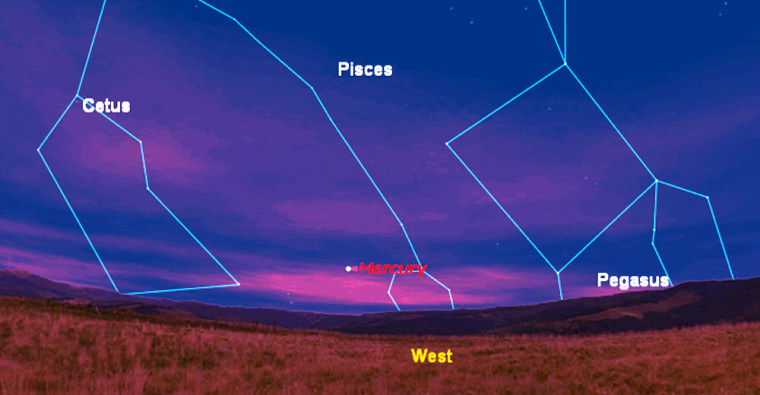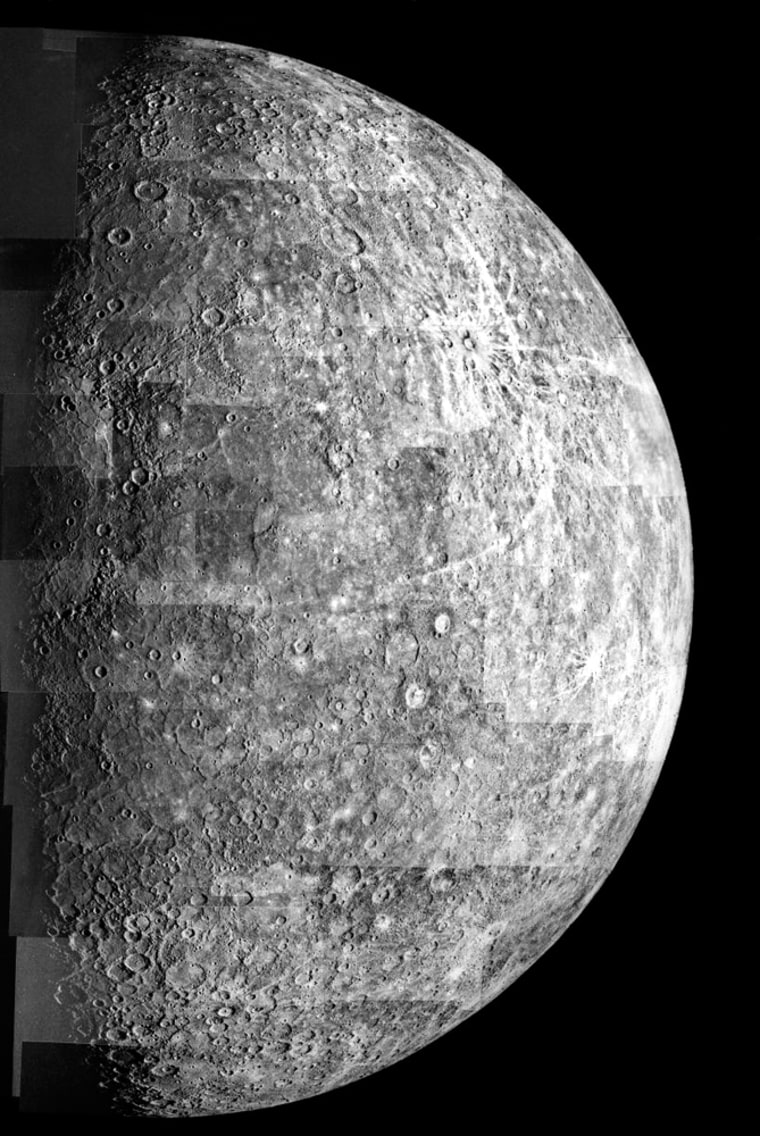The planet Mercury is often cited as the most difficult of the five bright planets to see.
Called an "inferior planet" because its orbit is nearer to the sun than Earth’s, Mercury — scarcely more than half as far from the sun as Venus is — always appears from our vantage point to be in the same general direction as the sun, and it’s usually lost in the sunlight.
Yet, it’s not really hard to see. You simply must know when and where to look, and find a clear horizon.
Three times a year this rocky little world emerges into the evening twilight for a few weeks. At three other times in the year it ventures a little way into the morning sky. Yet, even at these "greatest elongations" it can’t be easily seen unless other conditions are favorable. It is important, for instance, that Mercury be positioned as nearly directly above the sun’s place as possible, a condition that is best fulfilled just after sunset in the late winter or early spring and before sunrise in late summer or early autumn.
For those living in the Northern Hemisphere, a great window of opportunity for viewing Mercury in the evening sky has just opened up. The window will remain open through at least March 19, providing an ample number of chances to see this so-called elusive planet with your own eyes.
When and where
Currently, Mercury is visible about 45 minutes after sunset, very near to the horizon, just to the south (left) of due west. Yet, if your sky is clear and there are no tall obstructions to your view (such as trees or buildings) you should have no trouble in seeing it as a very bright "star" shining with just a trace of a yellowish-orange tinge.
On Friday evening, Mercury will be shining at magnitude –1.1, which means that only one other object in that same evening sky will be brighter: Sirius (the brightest of all stars).

In the evenings that follow, Mercury will slowly diminish in brightness, but it will also slowly gain altitude as it gradually moves away from the vicinity of the sun.
Be sure to cast a glance low toward the western horizon just after sunset on March 11. You will see a lovely, wire-thin crescent moon, less than 1½ days after passing through new-moon phase and only 3 percent illuminated. There, less than 4 degrees to the right and slightly below this slender sliver will be a bright "star" shining in the twilight — that's Mercury.
It will arrive at its greatest elongation the very next night, 18 degrees to the east of the sun. Take note that the moon will have moved well away from Mercury; far to its upper left. Shining this night at magnitude –0.2 (a trifle brighter than the star Arcturus, in the constellation of Boötes), Mercury sets more than 1½ hours after the sun, making this its best evening apparition of 2005.
Just a phase
Mercury, like Venus, appears to go through phases like the moon.
When March began, its disk was 86 percent illuminated by the sun, giving it a distinct gibbous appearance in telescopes, which is also why it started out the month appearing so bright. By the time it arrives at its greatest elongation, it will appear roughly half-illuminated, and the amount of its surface illuminated by the sun will continue to decrease in the days that follow.
So correspondingly, when it begins to turn back toward the sun’s vicinity after March 12, it will fade at a rather rapid pace.
In fact, by the evening of March 19, Mercury’s brightness will have dropped to magnitude +1.5, slightly dimmer than the star Regulus in Leo; only one-eleventh as bright as it was on March 4. (On the astronomers' magnitude scale, larger numbers represent dimmer objects.) In telescopes, Mercury will appear as a narrowing crescent phase. Thus, in all likelihood, March 19 will be one of your last views of it.
The combination of its lowering altitude, plus its descent into a much-brighter sunset glow, should finally render Mercury invisible by the final week of March. It will pass through inferior conjunction — between the sun and Earth — on March 30.
Legends and fact
In old Roman legends, Mercury was the swift-footed messenger of the gods. The planet is well named, for it is the closest planet to the sun and the swiftest of the sun’s family, averaging about 30 miles per second (48 kilometers per second). It makes its yearly journey in only 88 Earth days. Interestingly, the time it takes Mercury to rotate once on its axis is 59 days, so that all parts of its surface experience periods of intense heat and extreme cold.
Although its mean distance from the sun is only 36 million miles (58 million kilometers), Mercury experiences by far the greatest range of temperatures: nearly 900 degrees Fahrenheit (482 degrees Celsius) on its day side; minus-300 degrees F (-184 degrees C) on its night side.
In the pre-Christian era, this planet actually had two names, as it was not realized it could alternately appear on one side of the sun and then the other. Mercury was called Mercury when in the evening sky, but was known as Apollo when it appeared in the morning.
It is said that Pythagoras, in about the fifth century B.C., pointed out that they were one and the same.
Joe Rao serves as an instructor and guest lecturer at New York's Hayden Planetarium. He writes about astronomy for The New York Times and other publications, and he is also an on-camera meteorologist for , New York
